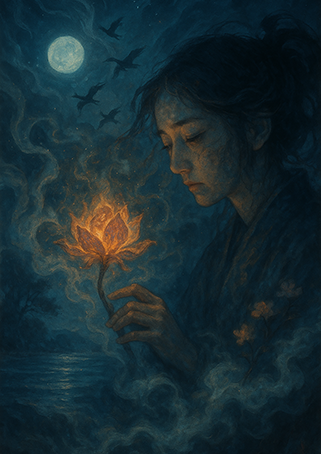Xieyi・The Rootless Tree:100 Verses-Verse 17#326

The poems of “The Rootless Tree” express a fundamental force rooted in harmony with heaven and earth, the cyclical flow of yin and yang, and the infinite potential of existence。
This painting is an expressive “Xieyi” in the tradition of “futu” (spiritual diagrams), passed down for generations in Wudang Mountain, China. It is drawn through a technique where energy flow (xingqi) channels the internal intention into visual form。 In the Taoist world, there exist spiritual and symbolic images called “futu”。
In the Taoist world, there exist spiritual and symbolic images called “futu”。
These are a type of talisman—not merely religious items, but expressive spiritual paintings that act directly on the mind of the viewer。
Since ancient times, many people have placed these Taoist-style “Xieyi” and futu in their homes, studies, or bedrooms, wishing for longevity, health, auspiciousness, and family harmony. Viewing such paintings was not just aesthetic appreciation, but an act of inviting the presence of the Dao into one’s life and tuning the body and mind。
Thus, “Xieyi” is more than artistic expression—it is a medium that bridges the spirit, life, and harmony with the universe。
This kind of artwork is not meant to be seen only with the eyes, but felt with the heart。
It communicates with the Dao, resonates with the qi of nature, and quietly stirs the viewer’s inner self。
Futu and “Xieyi” continue to live on from ancient times to this day as “sacred images that speak to the soul.”
Below, we present the original text of the philosophical poem “The Rootless Tree,” along with a modern Japanese translation and interpretation。
※ The author of “The Rootless Tree,” Zhang Sanfeng (1247–?), is also renowned as the founder of Tai Chi, and it is said that he applied the essence of this work to Tai Chi. As an additional note, we include an interpretation connecting this to the Tai Chi tradition of Wudang Mountain.
The Rootless Tree・Verse 17

▶Original Text
無根樹,花正火,烈焰中開不懼墮。燒盡形骸留真骨,灰中猶有赤心多。
▶Modern Translation
A fiery flower blazes on a rootless tree;
It blooms amid flames, unafraid to fall.
When body is burnt away, true bone remains—
From the ashes a crimson heart still glows.
▶Interpretation
1.[無根樹,花正火] Hidden passion erupts as flame.
2.[烈焰中開不懼墮] Unfearing commitment amid risk.
3.[燒盡形骸留真骨] Essence survives the burning of form.
4.[灰中猶有赤心多] Pure resolve endures even in ashes.
▶Interpretation related to Tai Chi
•Shed external form to reveal core gongfu.
•Extreme training exposes indestructible spirit.
•After explosive fajin, authentic energy still pervades.
Copyright © MASAKI WAKABAYASHI. All rights reserved.




